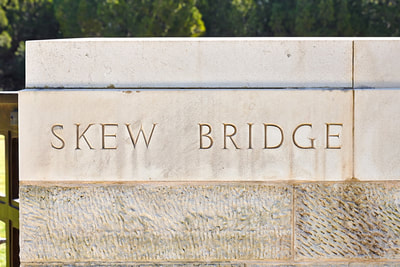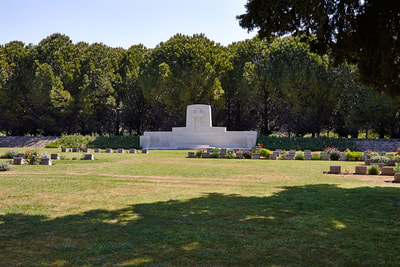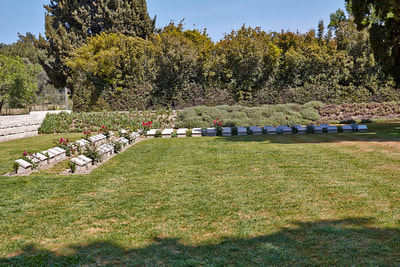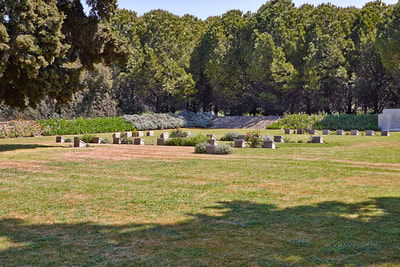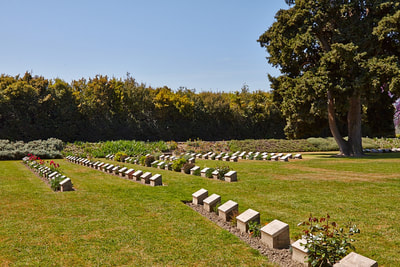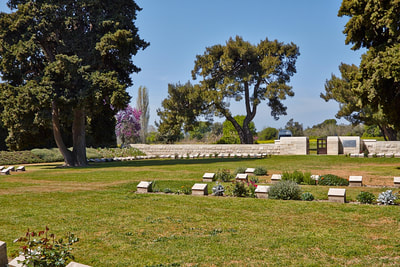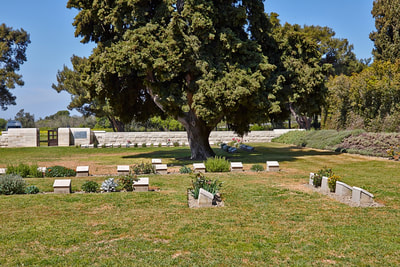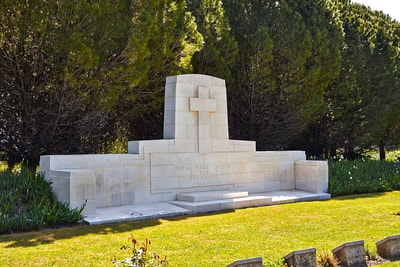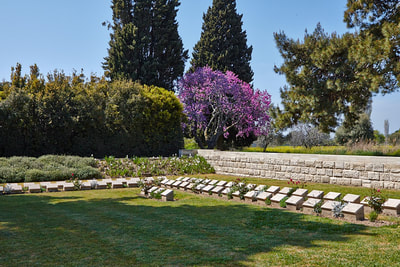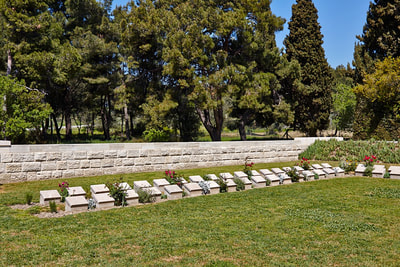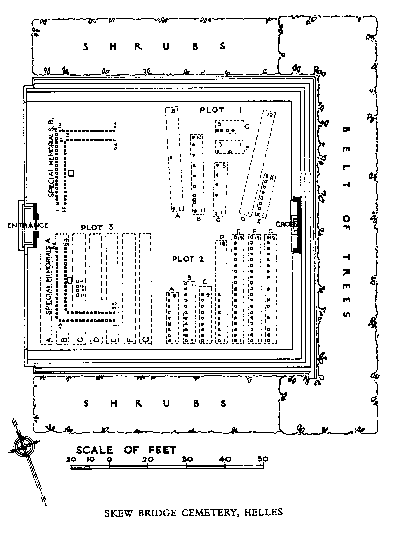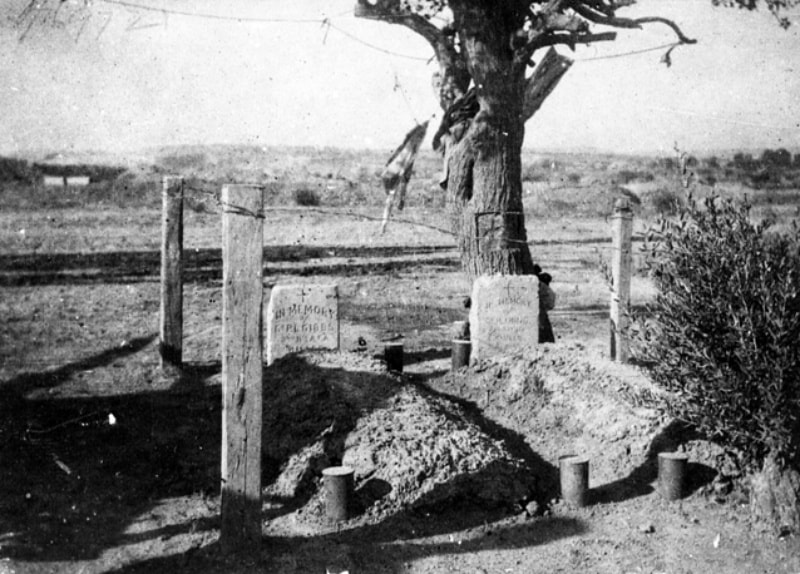SKEW BRIDGE CEMETERY
Gallipoli
Turkey
Location Information
Follow the road to Helles, opposite the Kabatepe Museum. After 14.2 km's, take a right turn at the 'T' junction and after 14.3 km's take the left fork. After a total of 25.2 km's, Skew Bridge cemetery will be found on the right, down a short track. It is also 2 km's north-east of Sedd-el-Bahr, between the road to Krithia and Kilid.
Visiting Information
The Cemetery is permanently open and may be visited at any time.
Historical Information
The eight month campaign in Gallipoli was fought by Commonwealth and French forces in an attempt to force Turkey out of the war, to relieve the deadlock of the Western Front in France and Belgium, and to open a supply route to Russia through the Dardanelles and the Black Sea.
The Allies landed on the peninsula on 25-26 April 1915; the 29th Division at Cape Helles in the south and the Australian and New Zealand Corps north of Gaba Tepe on the west coast, an area soon known as Anzac.
On 28 April, following the landings at Helles, the first attack was mounted towards Achi Baba, the ridge which dominates the southern part of the peninsula. Fatigue, however, brought the assault to a halt some kilometres short of the objective, near the village of Krithia. Turkish counter attacks followed but were repulsed and during the period 6-8 May, the 29th and French Divisions, reinforced by the 2nd Australian and New Zealand Infantry Brigades, carried out a renewed attack on Krithia, making some gains but suffering heavy casualties.
Between 1 May and the beginning of June, the 29th Indian Infantry Brigade and 42nd (East Lancashire) Division landed on the peninsula. With these reinforcements, the Allied force at Helles pushed forward once more on 4 June, but again to little effect. A further attack between 28 June and 5 July at Gully Ravine inflicted heavy casualties on the Turks, but despite local gains - at one point the line was pushed forward more than a kilometre - there was no breakthrough. By 13 July the advance at Helles was effectively over and the position remained unchanged until the evacuation in January 1916.
Skew Bridge Cemetery was named from a wooden "skew" bridge carrying the Krithia road across the Dere, just behind the centre of the line occupied by the Allied forces on 27 April 1915. It was begun during the fighting of 6-8 May and used throughout the occupation. At the Armistice it contained only 53 graves (Plot I, less Row E), but was greatly enlarged when further burials were brought in from the battlefields and from the following smaller cemeteries:- Orchard Gully, R.N.D., Backhouse Post and Romanos Well.
There are now 607 First World War servicemen buried or commemorated in this cemetery. 351 of the burials are unidentified but special memorials commemorate a number of casualties known or believed to be buried among them.
The cemetery covers an area of 2,210 square metres.
Identified Casualties
United Kingdom, 245
Australia 9
New Zealand 2
India 1
Cemetery pictures © Geerhard Joos
Follow the road to Helles, opposite the Kabatepe Museum. After 14.2 km's, take a right turn at the 'T' junction and after 14.3 km's take the left fork. After a total of 25.2 km's, Skew Bridge cemetery will be found on the right, down a short track. It is also 2 km's north-east of Sedd-el-Bahr, between the road to Krithia and Kilid.
Visiting Information
The Cemetery is permanently open and may be visited at any time.
Historical Information
The eight month campaign in Gallipoli was fought by Commonwealth and French forces in an attempt to force Turkey out of the war, to relieve the deadlock of the Western Front in France and Belgium, and to open a supply route to Russia through the Dardanelles and the Black Sea.
The Allies landed on the peninsula on 25-26 April 1915; the 29th Division at Cape Helles in the south and the Australian and New Zealand Corps north of Gaba Tepe on the west coast, an area soon known as Anzac.
On 28 April, following the landings at Helles, the first attack was mounted towards Achi Baba, the ridge which dominates the southern part of the peninsula. Fatigue, however, brought the assault to a halt some kilometres short of the objective, near the village of Krithia. Turkish counter attacks followed but were repulsed and during the period 6-8 May, the 29th and French Divisions, reinforced by the 2nd Australian and New Zealand Infantry Brigades, carried out a renewed attack on Krithia, making some gains but suffering heavy casualties.
Between 1 May and the beginning of June, the 29th Indian Infantry Brigade and 42nd (East Lancashire) Division landed on the peninsula. With these reinforcements, the Allied force at Helles pushed forward once more on 4 June, but again to little effect. A further attack between 28 June and 5 July at Gully Ravine inflicted heavy casualties on the Turks, but despite local gains - at one point the line was pushed forward more than a kilometre - there was no breakthrough. By 13 July the advance at Helles was effectively over and the position remained unchanged until the evacuation in January 1916.
Skew Bridge Cemetery was named from a wooden "skew" bridge carrying the Krithia road across the Dere, just behind the centre of the line occupied by the Allied forces on 27 April 1915. It was begun during the fighting of 6-8 May and used throughout the occupation. At the Armistice it contained only 53 graves (Plot I, less Row E), but was greatly enlarged when further burials were brought in from the battlefields and from the following smaller cemeteries:- Orchard Gully, R.N.D., Backhouse Post and Romanos Well.
There are now 607 First World War servicemen buried or commemorated in this cemetery. 351 of the burials are unidentified but special memorials commemorate a number of casualties known or believed to be buried among them.
The cemetery covers an area of 2,210 square metres.
Identified Casualties
United Kingdom, 245
Australia 9
New Zealand 2
India 1
Cemetery pictures © Geerhard Joos
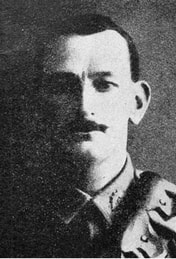
3 Corporal
Sydney Aubrey
1st Australian Field Artillery
28th September 1915, aged 35.
Plot I. C. 1.
Inscription "Our Sid"
Son of David Aubrey and the late Elizabeth Aubrey.
Click on image to enlarge
Studio portrait of 3 Corporal Sydney Ellis Aubrey, 1 Field Artillery Brigade of Paddington, NSW. A professional soldier, he embarked from Sydney aboard HMAT Argyllshire (A8) on 18 October 1914. He was wounded in action at Gallipoli, Turkey and died of his wounds on 28 September 1915, aged 35.
Sydney Aubrey
1st Australian Field Artillery
28th September 1915, aged 35.
Plot I. C. 1.
Inscription "Our Sid"
Son of David Aubrey and the late Elizabeth Aubrey.
Click on image to enlarge
Studio portrait of 3 Corporal Sydney Ellis Aubrey, 1 Field Artillery Brigade of Paddington, NSW. A professional soldier, he embarked from Sydney aboard HMAT Argyllshire (A8) on 18 October 1914. He was wounded in action at Gallipoli, Turkey and died of his wounds on 28 September 1915, aged 35.
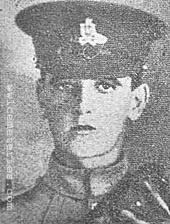
961 Gunner
Gerald Leslie Wilson Clegg
Royal Field Artillery
Killed in Action 3rd August 1915, aged 18.
Special Memorial A. 6.
Son of Thomas and Margaret A. Clegg, of 29, Robinson St., Burnley, Lancs.
Gerald Leslie Wilson Clegg
Royal Field Artillery
Killed in Action 3rd August 1915, aged 18.
Special Memorial A. 6.
Son of Thomas and Margaret A. Clegg, of 29, Robinson St., Burnley, Lancs.
282 Gunner Percy Lennie Gibbs, 1st Brigade, Australian Field Artillery, 2nd June 1915, aged 20. Plot I. E. 7. Son of Percy and Nellie Gibbs, of "Pernellen," Hyde Park Rd., Lidcombe, New South Wales. Native of Sydney, New South Wales.
Inscription "No sorrowful speech nor silent stone, can tell our loss, O hero son".
298 Gunner Henry John King, 1st Brigade, Australian Field Artillery, died 8th May 1915, aged 20. Plot I. E. 8. Son of Albert John and Jane King. Inscription "Lead kindly light"
Inscription "No sorrowful speech nor silent stone, can tell our loss, O hero son".
298 Gunner Henry John King, 1st Brigade, Australian Field Artillery, died 8th May 1915, aged 20. Plot I. E. 8. Son of Albert John and Jane King. Inscription "Lead kindly light"

